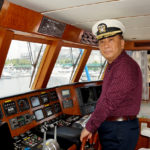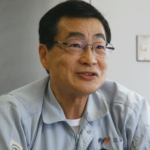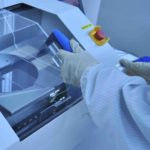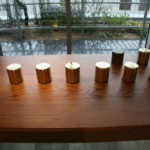Industrial computer system manufacturer Sanritz Automation Co. is the brains behind any number of industrial and social infrastructures in Japan. Katayama Osamu profiles the company.
Today, IT is used in every area of society. Computers play an important role in managing numerous facilities and equipment, such as factories, power plants, stations, logistical warehouses and stores as well as microcomputers embedded in home electric appliances, including televisions and refrigerators. Software that enables computers to work and systems that manage computers as a whole are essential to computers.
Sanritz Automation Co., which is headquartered in Machida, Tokyo, is an industrial computer system manufacturer with around 150 employees.
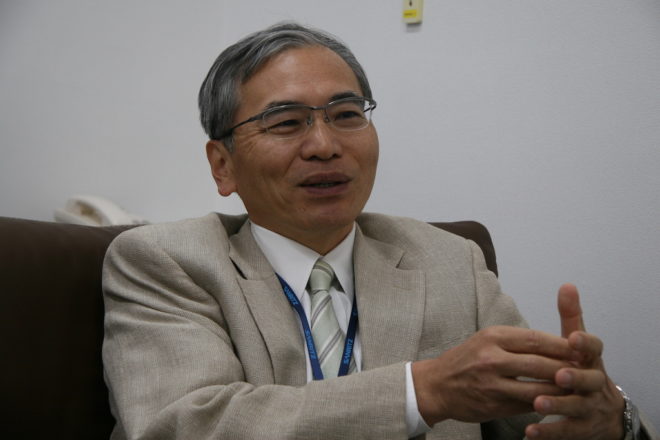
Suzuki Kazuya, president of Sanritz Automation Co.
KATAYAMA OSAMU PHOTO
“For embedded systems, we are dedicated to industrial devices including social infrastructures, not customer products including home electric appliances,” says Suzuki Kazuya, the company’s president. “We handle factory systems, such as automobile production lines and semiconductor manufacturing devices, and social infrastructure systems, such as electronic toll collection (ETC) systems and local airport remote monitoring systems.”
Sanritz Automation deals with the entire systems, including devices and embedded computers, and software that enables computers to work.
Sanritz Automation was founded in 1971. Suzuki Ichiro, the father of Kazuya, was originally an electric construction work engineer. He established Sanritz Automation Co. as a software developer, a designer and manufacturer of minicomputer and microcomputer systems, and an electronic equipment seller with the aim of achieving factory automation by computer.
The company’s first major project was the Traffic Control System for Tokyo Metropolitan Expressway in 1973.
Toshiba Corporation played a role as a system integrator, and Sanritz Automation participated in the project as a subcontractor. Sanritz Automation dealt with proposals regarding system design and the development of software that enables computers to operate. It was a major achievement for Sanritz Automation that it handled the advanced social infrastructure system of traffic control.
Sanritz Automation’s partnership with Toyota Motor Corporation in 1987 was an epoch-making milestone.
Toyota Motor Corporation is famous for its Toyota Production System (TPS). Toyota began to visualize production processes by using sensors and electronic tags in the 1970s. Sanritz Automation participated in streamlining and automating Toyota factories and introducing electronics for mechatronics apparatuses and mechatronics equipment.
Suzuki says, “Toyota first worked on visualization for improvements. If it conducted visualization using data and numbers, it could find problems and improve the situation. We helped it with this.”
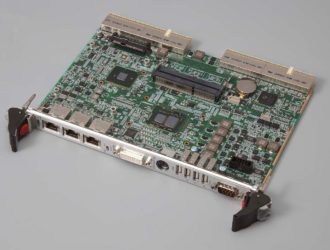
An industrial-use processor board for embedded applications manufactured by Sanritz Automation
COURTESY OF SANRITZ AUTOMATION CO., LTD.
Toyota aimed to achieve the integrated management of automobiles conveyed through production lines and information. It attached radio frequency identifier (RFID) tags, which were still expensive at that time, to every single platform truck of automobiles conveyed through production lines, and entered information about the manufacturing processes that those automobiles should undergo. Toyota sought to build a system for connecting that information with information about production support in computers to boost productivity and for removing operational errors to boost quality. This was, so to speak, the origin of the Internet of Things (IoT). Sanritz Automation supported it in terms of the system.
Suzuki says, “Automobile production lines create significant added value. Because it was possible to make major investments in equipment, Toyota worked on pioneering projects from an early stage.”
Ever since the high-speed economic growth period, the Japanese manufacturing industry, which surpasses all others in the world, has been supported by high-level production technologies. Sanritz Automation’s embedded computer system has supported IT and the networks of such production technologies.
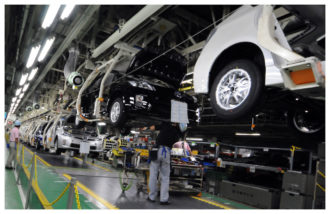
Sanritz Automation provides systems optimized for on-site applications such as Toyota Motor Corporation’s paint shops and assembly lines. Pictured, the Tsutsumi plant Prius assembly line.
COURTESY OF SANRITZ AUTOMATION CO., LTD.
Sanritz Automation is a Toyota-affiliated company with ownership of about 30% today as well. Sanritz Automation participates in the development and vertical development of production instruction systems for painting and assembly lines and the development of products related to factory automation, and also the ETC project and the development of Toyota Partner Robots, aside from factories.
Sanritz Automation is not satisfied with these, however. Today, Toyota’s percentages are declining consistently in all the projects. That is, Sanritz Automation is receiving orders from other areas.
Organizing Business Models
Suzuki Kazuya assumed the presidency in 2006. He was formerly a Fujitsu engineer.
Suzuki handled the terrestrial computer system of the Japanese Experiment Module (JEM), nicknamed Kibo (meaning “Hope”), which is a Japanese science module for the International Space Station (ISS) developed by JAXA, and the launch of a new project of digital tachograph operation management terminals for commercial vehicles of Intelligent Transport Systems (ITS). His father fell ill around the time when the new project was launched.
Initially, Suzuki’s father did not intend to ask his son to take over the company, and Suzuki himself did not intend to do so. But there were no prospective successors within the company, so the father asked his son for help.
After having interviews with Sanritz Automation’s executives, Suzuki decided to take over the family business.
“My starting point as a corporate manager was my experience of participating in the launch of a new project when I worked at Fujitsu,” Suzuki says. “I drew up business scenarios from the planning phase, developed plans and launched the project. Looking back on that time, I feel that it was a significant experience for me to take over the family business. It provided me with the opportunity to study a large number of management-related aspects, including capital, human resources and intellectual assets as well as technologies.”
The scale of the new project was similar to that of Sanritz Automation. Suzuki was able to obtain a feel for the business of small and medium-sized enterprises.
After taking office as president, the first thing Suzuki embarked on was to organize a corporate vision and the businesses.
Suzuki says, “I thought that I should not change our corporate culture of ‘Social Harmony, Original Ability, Creative Energy and Technical Bridge.’ On the other hand, I thought that I should change the businesses if necessary. After I collected my thoughts, I was able to clarify the things I should do as an extension of the conventional businesses and the things I should improve.” He gained a clear view of the company’s good and bad points, and also found it easier to formulate a future strategy.
For example, because the market conditions were changing rapidly due to silicon cycles in the area of semiconductors, their main business, he strengthened other business areas to reduce dependency. In addition, he focused on developing the final products.
Most of Sanritz Automation’s businesses were jobs related to parts or subcontracted jobs. In this situation, unless their customers continued to win in the market, they would be unable to survive.
Suzuki says, “Business that does not depend on customers is necessary in order for us to become a company that can maintain its businesses on its own. By using the hardware and software that we developed with embedded computers as strengths, we need to create devices that we produce on our own.”
In addition, he also aimed to dig deep into areas where the company could utilize its flagship technologies. For example, Sanritz Automation is the official supplier of Rescue Robot Contest. This is the result of efforts to think about how to utilize its flagship remote control technologies for robots.
For research and development, he discerned areas where the company has strong technologies, such as computer image processing and communications, and made a clear distinction between technologies to be accumulated within the company and technologies for which there is dependence on other companies. Not to expand business areas in a rough-and-ready way can be said to be the essence of the survival of small and medium-sized enterprises.
Small and Medium-sized Enterprises’ Strategy for Human Resources
In fact, after assuming the presidency of Sanritz Automation, Suzuki was surprised to discover how excellent their engineers were in terms of quality.
“Of management resources, including human resources, things, money and data, it is human resources, that is, engineers, who create value for Sanritz Automation. Because we were able to recruit human resources properly, our management went well.”
Sanritz Automation has a secret plan for its recruitment activities. It focuses on the students of the Colleges of Technology or KOSEN National Institute of Technology. Every year, most of the new recruits are the graduates of the KOSEN National Colleges of Technology. KOSEN National Institute of Technology, which provides a five-year engineering education, features closer relationships between the schools and students than universities, and there are many cases in which teachers introduce companies to students. Sanritz Automation has built up trust with the teachers of KOSEN National Institute of Technology and has developed channels for acquiring good human resources.
Suzuki says, “Many of the graduates of KOSEN National Colleges of Technology are earnest technician types. Many of them have also studied things close to the working fields and enjoy developing products.”
Earnest technician types are the very human resources that Sanritz Automation wants.
Sanritz Automation is a company that does not sell a wide variety of products to many customers, but it has gained firm trust from automobile manufacturers and particular customers who deal with social infrastructures and has continued to provide value for many years. The company treats customers honestly and invests a lot of time in building a system in line with customer needs.
“Large corporations are good at handling the upper stream of systems, whereas Sanritz Automation is good at designing things downstream and finishing them so that they can get moving,” says Suzuki. “Our strength is that our engineers work as hard and honestly as possible until the products can be used satisfactorily.”
Honest engineers are essential for maintaining the strengths of the policy of satisfying high-quality standards that customers expect from Sanritz Automation and of taking prompt measures, making thorough investigations into the causes and taking measures to prevent the recurrence of any problems that occur.
On the other hand, there are issues. Honest human resources for engineering are often poor at discovering and cultivating new business seeds.
To address this situation, Suzuki holds an in-house meeting called “Business Hypotheses Scenario Examination Meeting” about twice a month as part of employee training. Suzuki attends these meetings, which are an arena for examining business ideas that employees have come up with to make them more sophisticated.
“I think that a society where everyone makes plans and can create small businesses one after another is strong in the face of change and is more likely to survive,” Suzuki says.
Survival Strategy
Sanritz Automation has acquired a skill to survive cleverly through management that is suitable for its size. In fact, the company has achieved surpluses every year, except for the year when it was affected by the economic crisis.
The number of 150 employees can be viewed as a strength if it is used cleverly.
“Compared with large corporations, we work more efficiently with a smaller number of employees eliminating redundancies,” Suzuki says. “We will optimize our business as a company that is positioned between a large corporation and an individually managed company.”
For small and medium-sized enterprises to survive, they must avoid areas where they have to make huge investments.
Suzuki says, “We target markets that major companies do not target with a focus on efficiency. These are areas that require you to put in a lot of time and effort, are less attractive in spite of the technical requirements, and get left behind. It is possible to achieve healthy profits by putting in a lot of time and effort.”
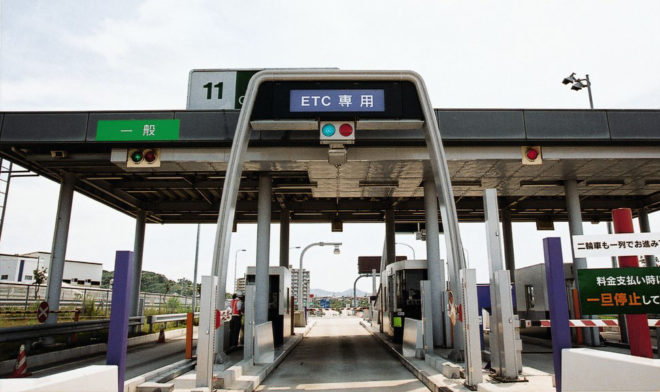
A typical electronic toll collection (ETC) booth on a highway in Japan. The non-stop drive-through ETC lane system developed by Sanritz Automation has significantly reduced congestion on Japan’s roads.
COURTESY OF SANRITZ AUTOMATION CO., LTD.
Social infrastructures still include such areas. Suzuki has created an organization that is competitive enough to continue to undertake businesses in which it has strengths and accomplish tasks to their conclusion in markets that do not grow significantly but continue for many years.
Sanritz Automation will continue to place its industrial computer system at the heart of its business. It is expanding its businesses to airports as well as roads in the area of social infrastructures. It is also considering expanding into the area of railroads in the future.
“Because there are reasons for the existence of social infrastructures, jobs in this area will never disappear,” Suzuki says.
Sanritz Automation will continue to play a role as the brain of common social infrastructures.
KATAYAMA Osamu is an economics journalist and representative of K-Office. He has published extensively, including Sumato kakumei de seicho suru Nihon keizai (Growing the Japanese Economy with the Smart Revolution), and Naze Za Puremiamu Morutsu ha uretsuzukeru noka? (Why does The Premium Malt’s beer sell so well?). Recent publications include Samsun kuraishisu (The Samsung Crisis).



